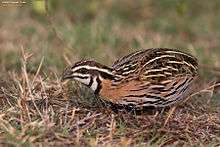Rain quail
| Rain quail | |
|---|---|
 | |
| Scientific classification | |
| Kingdom: | Animalia |
| Phylum: | Chordata |
| Class: | Aves |
| Order: | Galliformes |
| Family: | Phasianidae |
| Subfamily: | Perdicinae |
| Genus: | Coturnix |
| Species: | C. coromandelica |
| Binomial name | |
| Coturnix coromandelica (Gmelin, 1789) | |

The rain quail or black-breasted quail (Coturnix coromandelica) is a species of quail found in the Indian subcontinent, its range including Pakistan, India, Nepal, Sri Lanka, Bangladesh, Myanmar, Thailand, Cambodia and Viet Nam.[1]
Distribution

.jpg)
Grassland, cropped fields, and scrubs in the Indus valley of central Bangladesh, India, Nepal and Pakistan, ranging across the Gangetic plains, and parts of peninsular continental India. Mostly seen in winter further south.
Description
The rain quail lacks barring on primaries. The male has a black breast-patch and distinctive head pattern of black and white. The female is difficult to separate from female common quail and Japanese quail, although the spots on the breast are more delicate. It is 6–6.5 in (15–17 cm) and weighs roughly 2.25–2.5 oz (64–71 g).[2]
The call is a metallic chrink-chrink, constantly repeated mornings and evenings, and in the breeding season also during the night. It is quite unmistakably distinct from the call of the common grey quail.[3][4]
Behaviour
The rain quail feeds on seeds of grasses and other plants, insect larvae and small invertebrates. Breeding takes place between March and October, but chiefly after the start of the southwesterly monsoon season in June. The eggs are laid in a scrape in the ground, sometimes in the open under a Euphorbia or similar bush. There are usually six to eight eggs in the clutch. The incubation period is sixteen to eighteen days. The chicks are able to leave the nest soon after they have hatched and remain with their parents for about eight months.[5]
Status
The rain quail has a very large range and the population is stable. It is a common species and the International Union for Conservation of Nature has rated their conservation status as "least concern".[1]
References
- 1 2 3 BirdLife International (2012). "Coturnix coromandelica". IUCN Red List of Threatened Species. Version 2013.2. International Union for Conservation of Nature. Retrieved 6 August 2015.
- ↑ Jerdon, T.C. (1864). The Birds of India. III. Calcutta: George Wyman and Co. p. 589.
- ↑ Rasmussen, P.C. and J. C. Anderton 2005. Birds of South Asia. The Ripley Guide. Smithsonian Institution and Lynx Edicions.
- ↑ Ali, Salim; J C Daniel (1983). The book of Indian Birds, Twelfth Centenary edition. New Delhi: Bombay Natural History Society/Oxford University Press.
- ↑ Alaine Camfield. "Coturnix coromandelica: Rain quail". Animal Diversity Web. Retrieved 2015-08-06.
- BirdLife International (2004). "Coturnix coromandelica". IUCN Red List of Threatened Species. Version 2006. International Union for Conservation of Nature. Retrieved 6 May 2006.
